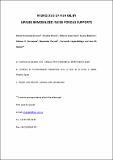Por favor, use este identificador para citar o enlazar a este item:
http://hdl.handle.net/10261/49912COMPARTIR / EXPORTAR:
 SHARE SHARE
 CORE
BASE CORE
BASE
|
|
| Visualizar otros formatos: MARC | Dublin Core | RDF | ORE | MODS | METS | DIDL | DATACITE | |

| Campo DC | Valor | Lengua/Idioma |
|---|---|---|
| dc.contributor.author | Fernández-Lorente, Gloria | - |
| dc.contributor.author | Pizarro, Carolina | - |
| dc.contributor.author | López-Vela, Dolores | - |
| dc.contributor.author | Betancor, Lorena | - |
| dc.contributor.author | Carrascosa, Alfonso V. | - |
| dc.contributor.author | Pessela, Benevides C. | - |
| dc.contributor.author | Guisán, José Manuel | - |
| dc.date.accessioned | 2012-05-21T11:13:34Z | - |
| dc.date.available | 2012-05-21T11:13:34Z | - |
| dc.date.issued | 2011 | - |
| dc.identifier | doi: 10.1007/s11746-010-1728-1 | - |
| dc.identifier | issn: 0003-021X | - |
| dc.identifier.citation | Journal of the American Oil Chemists' Society 88(6): 819-826 (2011) | - |
| dc.identifier.uri | http://hdl.handle.net/10261/49912 | - |
| dc.description.abstract | A new assay was designed to measure the release of omega-3 acids [eicosapentaenoic acid (EPA) and docosahexaenoic acid (DHA)] from the hydrolysis of sardine oil by lipases immobilized inside porous supports. A biphasic system was used containing the fish oil dissolved in the organic phase and the immobilized lipase suspended in the aqueous phase. The assay was optimized by using a very active derivative of Rhizomucor miehei lipase (RML) adsorbed onto octyl-Sepharose. Standard reaction conditions were: (a) an organic phase composed by 30/70 (v:v) of oil in cyclohexane, (b) an aqueous phase containing 50 mM methyl-cyclodextrin in 10 mM Tris buffer at pH 7.0. The whole reaction system was incubated at 25 °C. Under these conditions, up to 2% of the oil is partitioned into the aqueous phase and most of the 95% of released acids were partitioned into the organic phase. The organic phase was analyzed by RP-HPLC (UV detection at 215 nm) and even very low concentrations (e.g., 0.05 mM) of released omega-3 fatty acid could be detected with a precision higher than 99%. Three different lipases adsorbed on octyl-Sepharose were compared: Candida antarctica lipase-fraction B (CALB), Thermomyces lanuginosa lipase (TLL) and RML. The three enzyme derivatives were very active. However, most active and selective towards polyunsaturated fatty acids (PUFA) versus oleic plus palmitic acids (a fourfold factor) was CALB. On the other hand, the most selective derivatives towards EPA versus DHA (a 4.5-fold factor) were TLL and RML derivatives. | - |
| dc.language.iso | eng | - |
| dc.publisher | Springer Nature | - |
| dc.rights | openAccess | - |
| dc.title | Hydrolysis of fish oil by lipases immobilized inside porous supports | - |
| dc.type | artículo | - |
| dc.identifier.doi | 10.1007/s11746-010-1728-1 | - |
| dc.relation.publisherversion | http://dx.doi.org/10.1007/s11746-010-1728-1 | - |
| dc.date.updated | 2012-05-21T11:13:35Z | - |
| dc.description.version | Peer Reviewed | - |
| dc.type.coar | http://purl.org/coar/resource_type/c_6501 | es_ES |
| item.openairecristype | http://purl.org/coar/resource_type/c_18cf | - |
| item.fulltext | With Fulltext | - |
| item.cerifentitytype | Publications | - |
| item.openairetype | artículo | - |
| item.languageiso639-1 | en | - |
| item.grantfulltext | open | - |
| Aparece en las colecciones: | (ICP) Artículos (IFI) Artículos | |
Ficheros en este ítem:
| Fichero | Descripción | Tamaño | Formato | |
|---|---|---|---|---|
| Hydrolysis of fish.pdf | 372,76 kB | Adobe PDF |  Visualizar/Abrir |
CORE Recommender
SCOPUSTM
Citations
29
checked on 11-abr-2024
WEB OF SCIENCETM
Citations
28
checked on 19-feb-2024
Page view(s)
448
checked on 18-abr-2024
Download(s)
421
checked on 18-abr-2024
Google ScholarTM
Check
Altmetric
Altmetric
NOTA: Los ítems de Digital.CSIC están protegidos por copyright, con todos los derechos reservados, a menos que se indique lo contrario.
